Porro Prism vs Roof Prism Binoculars: Which is Best?
Last Updated on
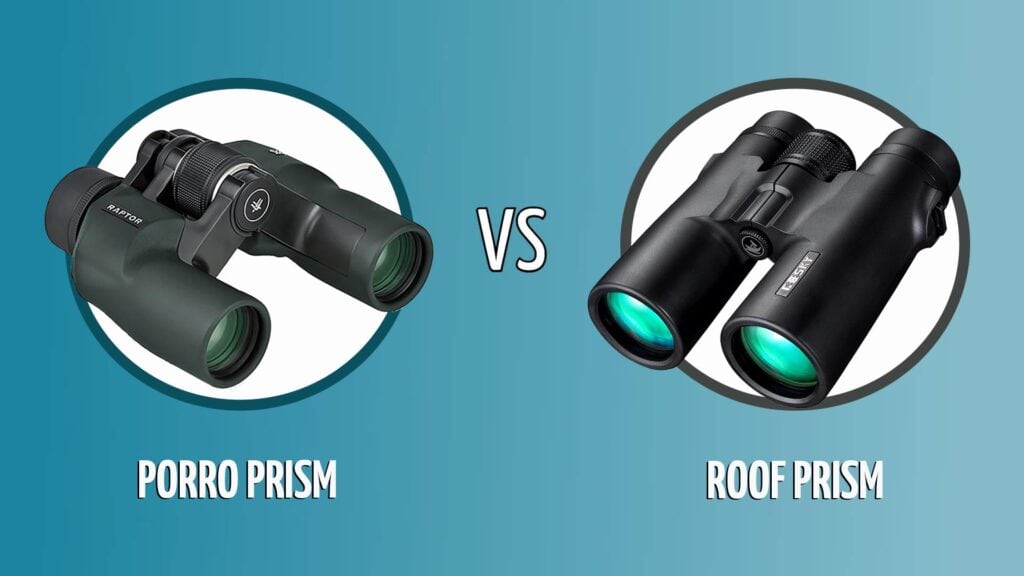
When it comes to binoculars, there are two main categories you’re going to need to decide between: Porro prism and Roof prism.
But which one is the best? It’s the easiest complicated answer ever: It depends.
It’s really one of those cases where the situation you’re needing them for actually makes the call. It’s always pertinent to use the right set for the job. However, what exactly are Porro prisms, Roof prisms, or prisms in general? In this article, we’ll go over what prisms are, how they work in binos, and what sets are best for what situations.
How Do Prisms Work in Binoculars?
Before we can really get into how prisms work in binos, we need to first understand what they are. By definition, a prism in optics is a transparent object — particularly one that is triangular in construction, that refracts light against its surfaces in order to separate white light into the spectrum of colors.
Now, that’s a mouthful. Let’s take a look into what that really means.
Prisms in binoculars are simple blocks of glass that act as mirrors. The keyword here is “act”. They are not true mirrors like you would find in a telescope. True mirrors have a reflective backing whereas prisms do not. Mirrors also produce a true image of what is being observed and not a virtual image created through light bending.
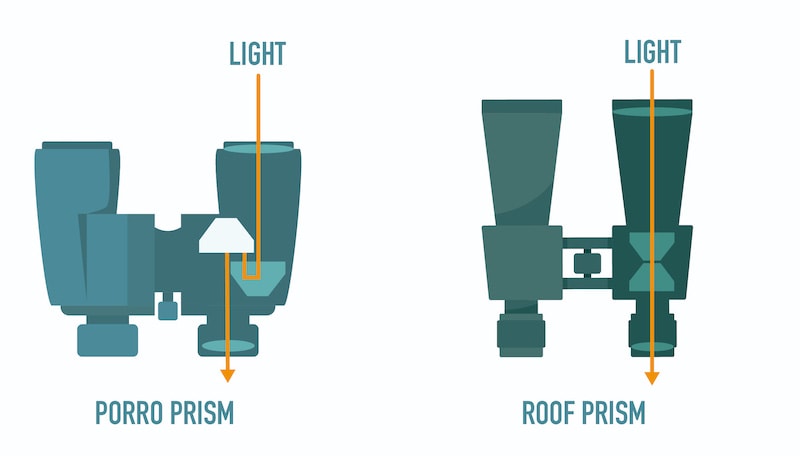
But let’s digress. These prisms reflect the incoming light through the objective lenses (that’s the one closest to your target) in order to amplify and create an image that is sent to the ocular lenses for you to observe. However, that’s not all that the prisms do. If the light were to be sent as-is, the image would appear upside down. However, the prisms also invert the image created, that way you can see things right side up.
BAK-4 and BK-7 Prism Glass: Which is Best?
Often, when shopping for binos, you’ll see the manufacturer advertising BAK-4 and BK-7 prism systems. What are those exactly? And which is better?
Well, each is a superior type of Porro prism (more on that later), but BAK-4 is generally considered the best. They have a truer round which can be observed by looking at the exit pupil of the bino set. BK-7 have a squared-off exit pupil thus less light transmission and edge-to-edge sharpness. You’ll often find BK-7 prism sets within lower-priced binoculars.
Porro Prisms
This type of prism set is the first set of prisms used in modern-day binoculars. They were first developed in the 19th century by Italian Ignazio Porro and are still being used to this day.
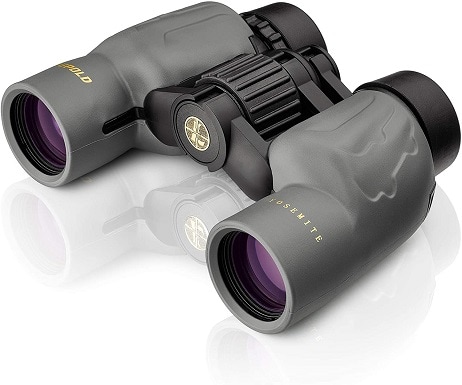
Porro Prisms work by sending the light captured by your objective lens through a pair of prisms in a quick horizontal movement. The movement between prisms acts as an amplifier and inverter to send a magnified and orientation corrected image of your target through the ocular lenses.
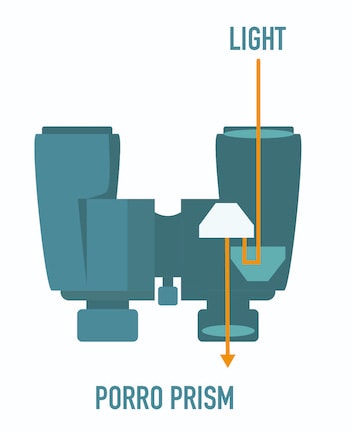
Porro prism binoculars are extremely easy to differentiate from other binos due to their zigzag or offset shape. This alone can make Porro prisms much heavier and more awkward to use than other binocular sets. And they’re a bit more fragile. However, they can give you a much clearer 3D image than other binocular sets along with a much larger field of vision.
But despite the zigzag, they’re actually the simplest binocular set design — which means they’re much cheaper to produce. And those savings very often get passed down to you, the consumer.
You’ll probably want to use Porro prism binoculars whenever you’re needing that extra clear image or wider FOV. They’re great for shorter range birding, hunting, sporting events, and general outdoor use.
- Superior in clarity
- Better depth perception
- Wider field of view (FOV)
- Overall improved image quality
- More bulk and weight
- Less waterproofing quality
- Lower durability
Our Favorite Porro Prism Binoculars
- With 8.5x magnification and 32mm objective lenses, this Raptor binocular has a wide-angle, porro...
- Fully multi-coated lenses transmit bright, crisp images with excellent color fidelity and clarity.
Roof Prisms
If you see a pair of straight tube binoculars, there’s a good chance you’re looking at a set equipped with Roof prisms.
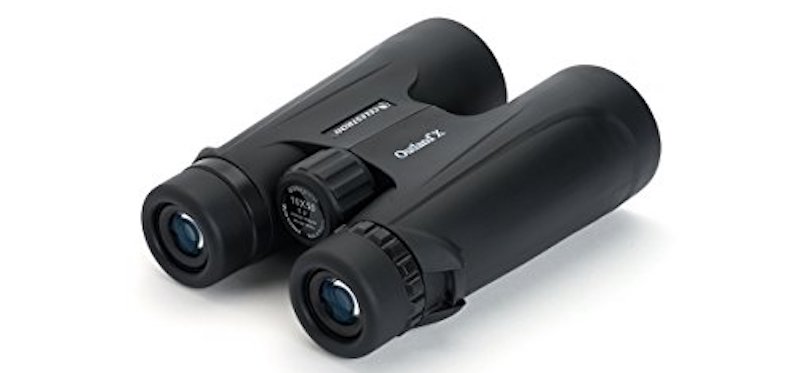
These are the more modern of the two types of binoculars. They’re more compact and streamlined, lighter weight, and much easier to carry around than the bulky Porro-style binos. And at first glance, they look to be more simplified as well.
However, such is not the case.
Their internal machinations are actually the most complex out of any other binocular style. And that’s because there’s no easy horizontal zig or zag. Remember, the movement of the light is what amplifies and inverts it as it reflects off the prisms. So, Roof prisms take advantage of intricate and convoluted machined paths that reflect the light from the objective to ocular lenses.

But this sequence isn’t complex for just for complexity’s sake. The light movement through Roof prisms can actually allow for much higher magnification powers and brighter end imagery.
The thing is though, they can get quite pricey. And that’s because they cost much more to make with all the specialty internal machining.
- More durability
- Lighter weight
- More compact
- Superior waterproofing
- Better magnification strength
- Slightly less clarity
- Narrower field of view (FOV)
- More expensive
Our Favorite Roof Prism Binoculars
- 8x magnification and 32mm objective lenses, these Diamondback binoculars are the workhorse of Vortex...
- Dielectric, fully multi-coated lenses transmit more light and clearer, brighter images. A field of...
Porro Prism vs Roof Prism – Which Is Best to Use?
As you can see, each prism type has its very own distinct advantages and disadvantages. Check out our handy table to see what we recommend during each situation.
| Porro Prism | Roof Prism | |
| Short-range birding | ||
| Long-range spotting | ||
| Stargazing | ||
| Daytime hunting | ||
| Nighttime hunting | ||
| General outdoor |
Price
There is a legitimate price difference between the two as well. Roof prism bino sets are often much more expensive than Porro prism designs of the same magnification.
So, if you’re on a tight budget, go ahead and look for a Porro prism set sporting BAK-4 prisms. They’ll provide just as vibrant an image as a corresponding Roof set at a fraction of the cost. And they’re much better for overall general use.
However, you’ll need to be extra careful not to break them. They are much easier to break than a Roof set. Broken binos means buying another set, which costs more than buying a single set of Roof binoculars.
Conclusion
Whichever set you decide is best for your situation is probably what you should go with. Don’t fall into the hype that Roof prism binos are better because they’re more expensive. And don’t run off and grab a set of Porro prism binos when you need the extra power a Roof can provide.
Buying for your situation is the best answer.
About the Author Robert Sparks
Robert’s obsession with all things optical started early in life, when his optician father would bring home prototypes for Robert to play with. Nowadays, Robert is dedicated to helping others find the right optics for their needs. His hobbies include astronomy, astrophysics, and model building. Originally from Newark, NJ, he resides in Santa Fe, New Mexico, where the nighttime skies are filled with glittering stars.
Related Articles:
How to Clean a Refractor Telescope: Step-by-Step Guide
How to Clean a Telescope Eyepiece: Step-by-Step Guide
How to Clean a Rifle Scope: 8 Expert Tips
Monocular vs Telescope: Differences Explained (With Pictures)
What Is a Monocular Used For? 8 Common Functions
How to Clean a Telescope Mirror: 8 Expert Tips
Brightfield vs Phase Contrast Microscopy: The Differences Explained
SkyCamHD Drone Review: Pros, Cons, FAQ, & Verdict


